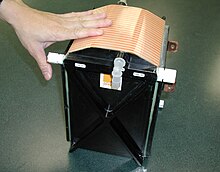금속 하이드라이드 연료전지
Metal hydride fuel cell금속수화물 연료전지는 연구 개발 중인 알칼리성 연료전지의 하위 등급이며,[1][2][3][4][5] 운영체제에서도 성공적으로 스케일업된다.[6][7] 주목할 만한 특징은 연료전지 자체 내에 수소를 화학적으로 결합하고 저장하는 능력이다.
특성.
금속 수화물 연료 전지는 다음과 같은 특성을 입증했다.[8][9][10]
- 전기 에너지로 재충전할 수 있는 기능(NiMH 배터리와 유사)
- 저온에서 작동( -20°C까지 낮음)
- 빠른 "콜드 스타트" 속성
- 외부 수소 연료 공급원 없이 제한된 시간 동안 작동 가능하여 연료 캐니스터의 "핫 스와핑" 가능
퍼포먼스
금속 수소 연료 전지의 전극 활성 영역이 60 cm에서2 2502 cm까지 확장되어 시스템을 최대 500 Watt까지 확장할 수 있게 되었다.[11] 전극 활성 영역의 스케일업 또한 각각 1500와트의 전력을 가진 더 높은 전력 연료 전지 스택을 개발할 수 있는 기능을 제공했다.[6] 금속 하이드라이드 연료전지는 250mA/cm의2 전류 밀도를 달성했다.[12] 내구성을 시험하기 위해 연료전지 스택을 7000시간 이상 성공적으로 가동했다.[12]
운영 체제 및 애플리케이션
제품 개발 초기 단계에서는 단일 연료 전지 및 다중 셀로 구성된 연료 전지 스택에 초점을 맞추었다. 대상 애플리케이션에는 군사 및 상용 애플리케이션을 위한 중요한 백업 성능이 포함되었다.[13] 다음 단계는 실험실 밖에서 취할 수 있는 완전한 연료전지 시스템을 설계하고 구축하는 것이었다. 초기 50와트 실험실 기반 시연 시스템은 50와트 휴대용 시스템에 통합되어 보다 견고한 포장 및 인터페이스가 제공되었다.[12] 연료전지 스택과 시스템 통합의 추가 개발로 인버터 및 금속 하이드라이드 저장통을 사용하는 온보드 수소 저장장치를 갖춘 1.0kW 시스템이 대중 앞에서 작동 및 시연될 수 있었다.[6][14] 금속 수화물 연료전지 시스템의 추가 개발은 병사들의 현장 전력 수요를 위해 추진되었고, 그 결과 배치 요건을 충족하는 시제품 시스템이 개발되었다.[15] 제품 개발과 더불어 제조 및 시험 역량 개발에도 초점을 맞췄다.[16] 금속 하이드라이드 연료전지 시스템은 시험과 평가를 위해 군사기지의 마이크로그리드 시스템에 통합되었다.[17] 도전에도 불구하고 군은 무인항공기, 자율 수중차, 경형트럭, 버스, 웨어러블 기술 시스템 등 광범위한 응용을 위해 연료전지에 대한 적극적인 관심을 유지하고 있다.[18][19][20][21][22] 탑재 수소 생성과 연료전지가 5.0kW에 이르는 등 군사용 응용을 위한 금속수화물 연료전지 시스템 개발이 계속되고 있다.[23][24]
참고 항목
참조
- ^ Chartouni, D.; Kuriyama, N.; Kiyobayashi, T.; Chen, J. (2002-09-01). "Metal hydride fuel cell with intrinsic capacity". International Journal of Hydrogen Energy. 27 (9): 945–952. doi:10.1016/S0360-3199(01)00186-0. ISSN 0360-3199.
- ^ Wang, Chunsheng; Appleby, A. John; Cocke, David L. (2004). "Alkaline Fuel Cell with Intrinsic Energy Storage". Journal of the Electrochemical Society. 151 (2): A260. Bibcode:2004JElS..151A.260W. doi:10.1149/1.1640627.
- ^ Wang, X.H.; Chen, Y.; Pan, H.G.; Xu, R.G.; Li, S.Q.; L.X., Chen; Chen, C.P.; Wang, Q.D. (20 December 1999). "Electrochemical properties of Ml(NiCoMnCu)5 used as an alkaline fuel cell anode". Journal of Alloys and Compounds. 293–295: 833–837. doi:10.1016/S0925-8388(99)00367-9.
- ^ Tanaka, H.; Kaneki, N.; Hara, H.; Shimada, K.; Takeuchi, T. (April 1986). "La—Ni system porous anode in an alkaline fuel cell". The Canadian Journal of Chemical Engineering. 64 (2): 267–271. doi:10.1002/cjce.5450640216.
- ^ Lee, S.; Kim, J.; Lee, H.; Lee, P.; Lee, J. (29 March 2002). "The Characterization of an Alkaline Fuel Cell That Uses Hydrogen Storage Alloys". Journal of the Electrochemical Society. 149 (5): A603. Bibcode:2002JElS..149A.603L. doi:10.1149/1.1467365.
- ^ a b c Fok, Kevin; English, Nathan; Privette, Robert; Wang, Hong; Wong, Diana; Lowe, Timothy; Madden, Paul (October 2008). "Powering Up Metal Hydride Fuel Cells for Military Applications". Fuel Cell Seminar & Exposition 2008. Retrieved 22 March 2020.
- ^ Lototskyy, Mykhaylo; Tolj, Ivan; Pickering, Lydia; Sita, Cordellia; Barbir, Frano; Yartys, Volodymyr (February 2017). "The use of metal hydrides in fuel cell applications". Progress in Natural Science: Materials International. 27 (1): 3–20. doi:10.1016/j.pnsc.2017.01.008.
- ^ Ovshinsky, Stanford; Fok, Kevin; Venkatesan, Srinivasan; Corrigan, Dennis (May 2–4, 2005). "Metal Hydride Fuel Cells For UPS And Emergency Power Applications". BATTCON 2005 International Battery Conference and Trade Show.
- ^ Schwartz, Brian; Fritzsche, Hellmut (28 February 2009). The Science and Technology of an American Genius: Stanford R Ovshinsky. World Scientific Pub Co Inc. ISBN 978-9812818393.
- ^ Encyclopedia of electrochemical power sources. Garche, Jürgen., Dyer, Chris K. Amsterdam: Academic Press. 2009. ISBN 9780444527455. OCLC 656362152.
{{cite book}}: CS1 maint : 기타(링크) - ^ Fok, Kevin (4 December 2006). "Metal Hydride Fuel Cells, A New and Practical Approach for Backup and Emergency Power Applications". INTELEC 06 - Twenty-Eighth International Telecommunications Energy Conference: 1–6. doi:10.1109/INTLEC.2006.251656. ISBN 1-4244-0430-4. S2CID 43062441.
- ^ a b c Fok, Kevin (May 2007). "Recent Advances in Metal Hydride Fuel Cell Technology for UPS/Emergency Power Applications". Battcon Stationary Battery Conference. Retrieved 22 March 2020.
- ^ Materials for fuel cells. Gasik, Michael, 1962-, Institute of Materials, Minerals, and Mining. Boca Raton: CRC Press. 2008. ISBN 978-1-84569-483-8. OCLC 424570885.
{{cite book}}: CS1 maint : 기타(링크) - ^ Godula-Jopek, Agata; Jehle, Walter; Wellnitz, Jorg (November 2012). Hydrogen Storage Technologies: New Materials, Transport and Infrastructure. Wiley‐VCH Verlag GmbH & Co. KGaA. doi:10.1002/9783527649921. ISBN 9783527649921.
- ^ Lowe, T. D. (2008). "Mobile Fuel Cell Configurations for the U.S. Military". Ohio Fuel Cell Symposium 2008.
- ^ Energy Technologies, Inc. (December 17, 2009). "Energy Technologies Awarded Third Ohio Third Frontier Fuel Cell Grant for Advanced Research, Development & Commercialization". Energy Technologies, Inc. Retrieved 2020-06-14.
- ^ Madden, P. D. (March 23, 2016). "Modular, Scalable, Micro Grid Incorporating Traditional and Renewable Energy Systems". Microgrid Global Summit 2016.
- ^ "Fuel Cells Fail to Make Inroads With the Military". www.nationaldefensemagazine.org. Retrieved 2020-03-24.
- ^ "4 Ways Fuel Cells Power Up the U.S. Military". Energy.gov. Retrieved 2020-03-24.
- ^ "Chevrolet Silverado ZH2 is a Fuel Cell-Powered Heavy-Duty Military Truck". Automobile. 2018-11-07. Retrieved 2020-03-25.
- ^ Judson, Jen (2017-08-08). "Hydrogen fuel cell technology could bring stealth to Army vehicles". Defense News. Retrieved 2020-03-25.
- ^ "Air Force demonstrating hydrogen as alternate fuel source". U.S. Air Force. Retrieved 2020-03-25.
- ^ "Energy Technologies Inc. - Onsite Hydrogen". www.onsitehydrogen.com. Retrieved 2020-06-03.
- ^ "Ultimate Fuel Cells". Ultimate Fuel Cells. Energy Technologies Inc. Retrieved 22 March 2020.




